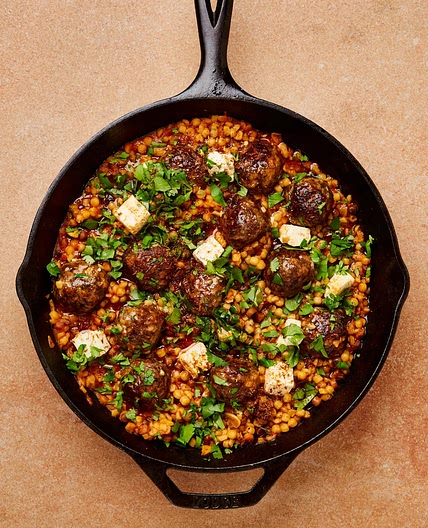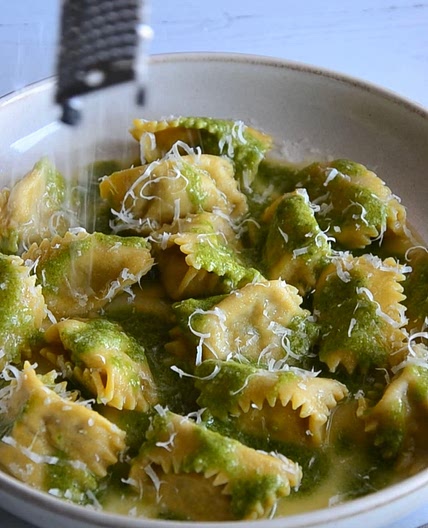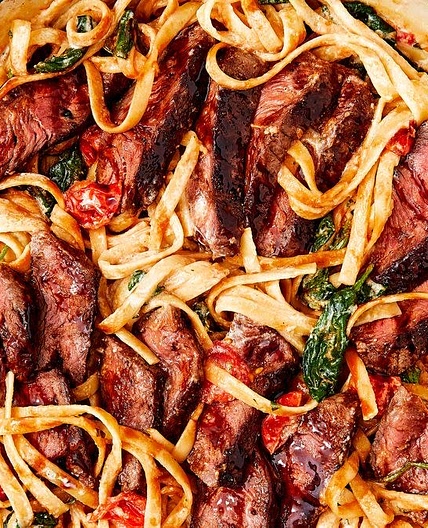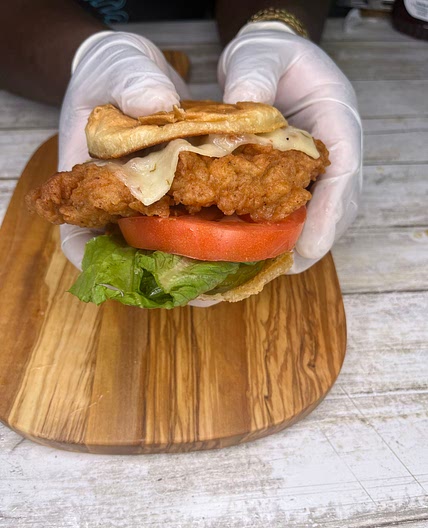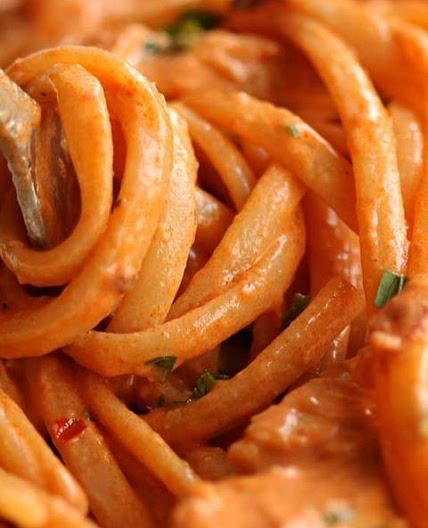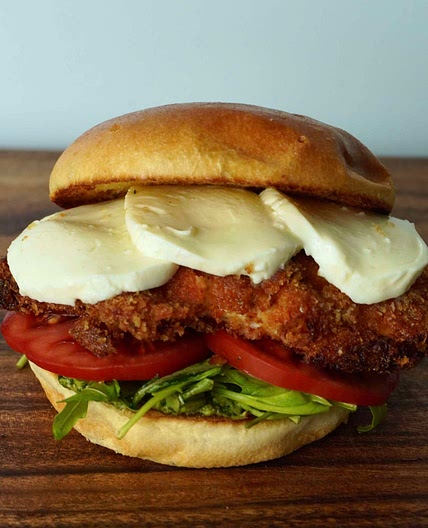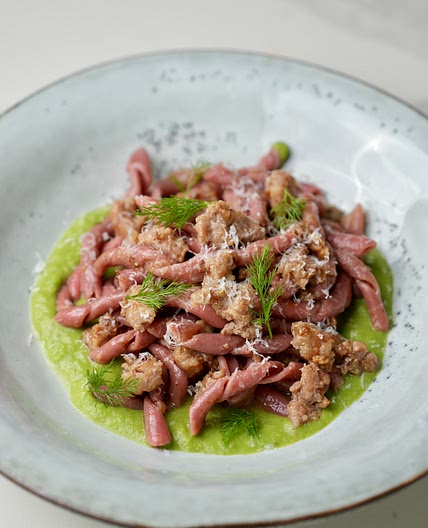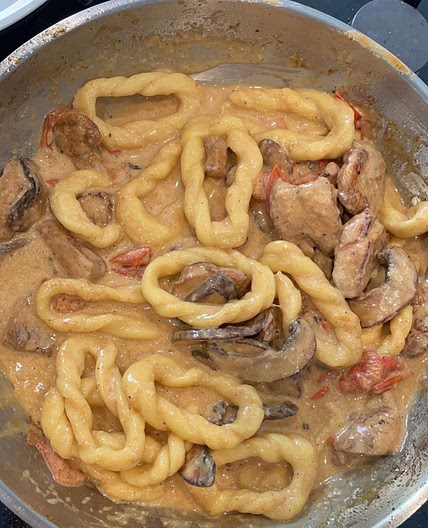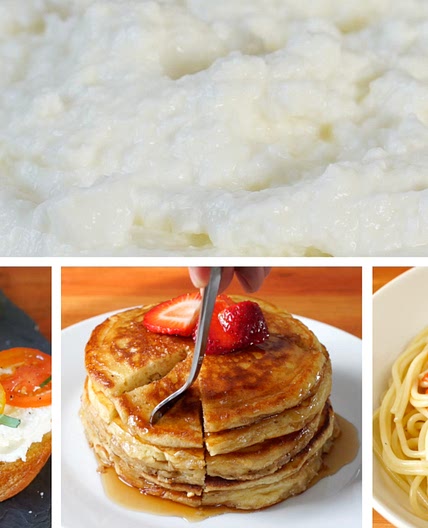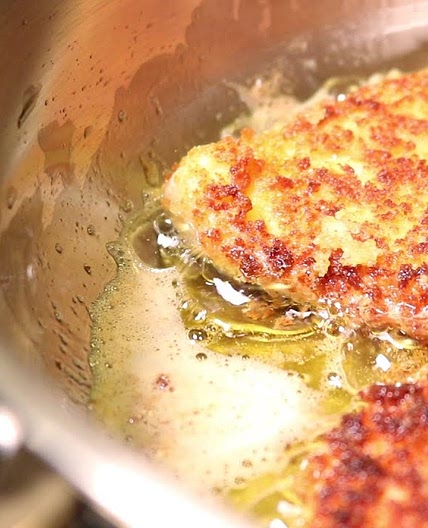By Alexander Evers
Orrichiette with fennel sausage and Swiss chard
Updated at: Sat, 25 Jan 2025 13:52:31 GMT
Nutrition balance score
Unbalanced
Glycemic Index
55
Moderate
Glycemic Load
80
High
Nutrition per serving
Calories3032.7 kcal (152%)
Total Fat214 g (306%)
Carbs144.3 g (55%)
Sugars12.4 g (14%)
Protein122.2 g (244%)
Sodium8105.5 mg (405%)
Fiber11.1 g (40%)
% Daily Values based on a 2,000 calorie diet
Ingredients
4 servings
For the chard
1 bunchswiss chard
¼ cupextra-virgin olive oil
kosher salt
0.5yellow Spanish onion
large, thinly sliced
12garlic cloves
thinly sliced lengthwise
2dried arbol chiles
Finishing
0.75 poundFennel Sausage
½ teaspoonaleppo pepper
1 cupChicken Stock
Basic, or 1/4 cup salted pasta water mixed with 1/4 cup plain water
3 tablespoonsunsalted butter
kosher salt
3 tablespoonsextra-virgin olive oil
finishing-quality
¼ cupParmigiano Reggiano
freshly grated
2 teaspoonsfennel pollen
2 tablespoonsbread crumbs
toasted
Fennel Sausage (makes 5 pounds)
3 Tbspfennel seeds
4 poundsboneless pork shoulder
1 poundpork fatback
3 tablespoonsgarlic
finely chopped
1 tablespoonskosher salt
2 tablespoonssugar
2 tablespoonsblack pepper
freshly ground
2 tablespoonshot paprika
1 tablespoonfennel pollen
¼ cupred wine vinegar
¾ cupwater
ice
Dough
Instructions
Fennel Sausage
Step 1
Toast the fennel seeds in a small skillet over high heat, shaking the skillet to keep the seeds from burning, until they are fragrant, about 1 minute. Pour the seeds onto a plate and set aside to cool to room temperature.
Step 2
Cut the pork shoulder and fatback into 1-inch cubes and put the cubes in a large bowl. In a small bowl, combine the garlic, salt, sugar, pepper, paprika, fennel pollen, and toasted fennel seeds. Stir the seasonings together and sprinkle them over the pork and fatback.
Step 3
Toss to coat the meat with the seasonings, cover the bowl tightly with plastic wrap, and refrigerate for at least 24 hours and up to two days. (If you are in a hurry, you can put the meat in the freezer until it is ice cold, but not frozen.)
Step 4
Fit a meat grinder with the largest die and have the bowl of a standing mixer handy. Remove the meat from the refrigerator (or freezer) and pass it through the grinder, catching the gound meat into the mixer bowl.
Step 5
Fit the standing mixer with the paddle attachment. Combine the vinegar and ice water.
Step 6
Put the bowl with the ground meat in it on the standing mixer and mix them on low speed, gradually adding the vinegar and water until the meat is slightly sticky; you may not use all of the liquid. Use the sausage according to your recipe, or transfer it to an airtight container or several containers. Refrigerate the sausage for up to five days or in the freezer for up to three months.
Dough
Step 7
Combine the flour, semolina, and water in the bowl of a standing mixer fitted with the paddle attachment and mix on low speed until the dough comes together. Turn off the mixer, remove the paddle attachment, and replace it with the dough hook.
Step 8
Scrape down the sides of the bowl and beat the dough with the dough hook on medium speed until it forms a ball, about 5 minutes. Dust a flat work surface with flour. Turn the dough out onto the dusted surface and gently knead it for 20 to 25 minutes, until the ball begins to feel elastic and the surface of the dough feels smooth and silky. Wrap the dough in plastic wrap and refrigerate to rest for at least 45 minutes and up to overnight before sheeting it (any longer and the dough will discolor).
Pasta
Step 9

Slice the round of dough into 1-inch-thick slabs and cut each slab into 1-inch-wide slabs. Roll each section on a clean, dry work surface into a tube ¼ inch thick, and set aside. Dust the work surface with flour, and return the tubes to the dusted surface.
Step 10

Use a long knife or a straight-edged rolling pastry cutter to cut the dough into 1-inch-long pieces, discarding the misshapen ends. Dust a baking sheet lightly with semolina. Dust a plastic cutting board or other slightly textured surface very lightly with flour.
Step 11

Place one pasta segment on the cutting board with the cut end facing you. With the flat side of the tip of a table knife, gently press on the end of the segment closest to you and continue pressing away from you toward the other end of the segment, flattening the dough into a small disk about ¼ inch thick in the process. Pick up the disk and invert it onto your index finger so that the side of the dough you pressed on is facing down. Use the fingers of your other hand to pull the edges of the dough around the index fin-ger, forming a caplike-shaped ear. Place the pasta shape on the prepared baking sheet and re-peat, shaping the remaining dough segments in the same way. Use the orecchiette or cover the baking sheet with plastic wrap and refrigerate the pasta for up to one day. To freeze, place the baking sheet in the freezer until the pasta is firm to the touch. Transfer the pasta to sealable plastic bags, or an airtight container, dusting off the excess semolina, and freeze for up to two weeks (any longer and the pasta will dry out and crack).
Cook Chard
Step 12
To prepare the chard, pull the leaves from the ribs. Roughly chop the leaves and set aside. Cut off and discard the very ends of the ribs and slice the ribs ¼ inch thick.
Step 13
Heat the olive oil in a large sauté pan over medium-high heat until it is almost smoking and slides easily in the pan, 2 to 3 minutes. Add the chard ribs, season with salt, and sauté for 2 to 3 minutes, until barely translucent. Add the onion, garlic, and chiles, and season with salt. Sauté the vegetables for about 10 minutes, adding water to the pan (as much as 1 cup total), stirring often to prevent the vegetables browning. (You add water to the pan so you can sauté and sweat the onion without browning it, but you never want the onion swimming in water-just enough so the pan isn't dry.)
Step 14
Add the chard leaves, season with salt, and fold the leaves in with the onion for 1 or 2 minutes to wilt them slightly. Reduce the heat to low, cover, and cook for 15 to 20 minutes, stirring from time to time, until the chard leaves are very dark green and the onion, leaves, and stems are one soft, homogenous mixture. Turn the vegetables out onto a cutting board and chop, cutting first in one direction and then perpendicular to the first direction, until the vegetables are finely chopped to the point of being almost puréed. Measure out a heaping ¼ cup of the vegetables for the pasta dish. Use the rest as an excuse to prepare this dish again in the very near future, or spoon a heaping spoonful under a piece of grilled fish, topped with a spoonful of Salsa Verde.
Prepare Sauce
Step 15
To make the sauce, heat a sauté pan over high heat for about 2 minutes until it's very hot. Add the sausage to the pan and cook it undisturbed for about 2 minutes, until the meat is seared. Stir the meat and cook for another 4 minutes, breaking it into pea-size pieces, until it is cooked through.
Step 16
Add the chopped chard and cook for 2 to 3 minutes to warm it through, stirring the chard into the sausage as it cooks. Sprinkle the pepper over the chard and sausage, add the chicken stock, and cook the sauce for 2 minutes, stirring constantly, to bring the ingredients together. Add the butter, stir until it melts, and turn off the heat while you cook the pasta.
Cook
Step 17
Fill a pasta pot or large stockpot with 6 quarts of water, add 6 tablespoons of salt, and bring the water to a boil over high heat. If you are not using a pasta pot, place a colander in the sink or have a large wire strainer handy to lift the pasta out of the pot.
Step 18
Remove the orecchiette from the refrigerator or the freezer and drop them into the boiling water. Stir to prevent the pasta from sticking together, partially cover the pot so the water returns to a boil quickly and continues boiling, and cook the pasta until it's al dente, about 2 minutes. About 1 minute before the pasta is done, place the sauce over high heat. Lift the pasta out of the cooking water or drain it and immediately add it to the pan with the sauce. Cook the pasta with the sauce together for 1 to 2 minutes, stirring with a rubber spatula, until the sauce is thick, adding fresh water to the pan if the pasta looks dry or sticky instead of slippery and glistening. Turn off the heat and add the finishing-quality olive oil, Parmigiano-Reggiano, and fennel pollen, stirring vigorously and shaking the pan to emulsify the sauce.
Step 19
Pile the orecchiette in the center of each of eight plates, dividing it evenly, and spoon any sauce left in the pan over the pasta. Sprinkle a generous tablespoon of bread crumbs over each serving, and serve with the remaining bread crumbs on the side.

